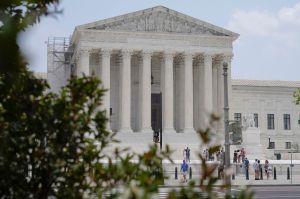Student loan forgiveness is over. How will KYians be impacted?
Published 8:00 am Friday, July 14, 2023

- Western Kentucky University students walk to classes along Normal Street in 2022. (Grace Ramey/photo@bgdailynews.com)
Allison Wiseman had already received her acceptance email from the Department of Education for $10,000 in student loan forgiveness when the U.S. Supreme Court ruled it unconstitutional.
In a 6-3 decision June 30, the Court ruled that President Joe Biden didn’t have the authority to execute his plan to forgive a portion of student loans for over 43 million borrowers in light of the COVID pandemic.
Now, Wiseman and 616,000 Kentuckians are back on the hook when loan payments restart this October.
In August 2022, Biden announced his plan to forgive between $10,000 and $20,000 of borrowers’ student loans — $10,000 for those who earned less than $125 a year and $20,000 for those who also received Pell Grants.
If enacted, the plan would have entirely erased student loans for 20 million Americans, and covered a portion of another 23 million American’s loans. It would have cost $400 billion.
Biden used a section of the Higher Education Relief Opportunities for Students Act to justify the move.
The HEROES Act states that the Education Secretary can “waive or modify” any provision of student loan programs as they deem “necessary” in response to a war, other military operation or national emergency, like the COVID-19 pandemic.
However, in a 6-3 decision, the Court ruled that the HEROES Act did not give the Education Secretary that much power over student loans.
“The Secretary may make modest adjustments to existing provisions, not transform them,” Chief Justice John Roberts’ opinion stated. “… The plan constitutes “effectively” a ‘whole new regime.’ ”
Roberts wrote that only Congress has the authority to execute that level of mass debt cancellation.
Under Biden’s plan, 209,400 Kentucky borrowers who owe less than $10,000 in student loan debt — 34% of all Kentucky borrowers — would have had their debts cancelled, according to a 2021 KyPolicy report.
Another 406,200 would have been eligible to have a portion forgiven.
Wiseman, who graduated from Hanover in 2019 and American University in 2021, is one of those Kentuckians.
When Wiseman and her parents took out student loans, they did not know what they were doing, she said.
Wiseman’s mother went to college on a full-ride athletic scholarship and her father was able to pay his way through in the late 80s and early 90s when college tuition cost about $1,000 per semester.
Wiseman was the first in her family to have to truly understand what it meant to loan out money to attend college, she said.
“My college did a horrible job of helping me figure out what to do and apply for more scholarships,” she said. “High school counselors really didn’t do much either, so we had no idea what we were doing. And it’s really, really difficult for people like me and others who had no idea what we were doing to now be in this much debt and not have any type of assistance to help us out.”
Wiseman took out a loan to pay for undergrad, and so did both her parents, through federal Parent PLUS loans, high-interest loans that parents are responsible for repaying.
Now, they owe a combined $186,000.
Before the Supreme Court decision, Wiseman was planning to use the $30,000 in forgiveness her family would have qualified for to pay off her dad’s entire debt.
Then, she said she would have been able to reconfigure her financial situation.
“And so I was completely planning on doing that, I was actually a little bit excited about it because even though it would have sucked to have to drain my savings on that loan, I knew that loan would have been done because of that $10,000 forgiveness,” Wiseman said.
In September, loan interest will start accruing again after a three-year COVID pause. In October, payments will be due.
Hannah Hartley, a 2020 graduate, is preparing to make her first payment.
Hartley was a non-traditional student. She went to one year of college after high school, but then what was intended as a gap year turned into seven.
Her parents intended to pay for her education whenever she decided to re-enroll, Hartley said, but they unexpectedly passed away before she got the chance.
Suddenly, paying for college got a lot more difficult. Instead, Hartley got a well-paying job for a private tech company. But right before turning 27, she decided to go back to school for a career change that felt more fulfilling.
But to do that, she had to take out federal loans and a private loan. Now, she owes $27,000.
She said the $10,000 relief would have balanced out the interest that would likely accrue on her debt as she worked to pay it off over the next decade.
Since she now works at a nonprofit, she said her earning potential is lower. Hartley added that she has no problem paying off the principal, but is frustrated by how quickly interest will accrue on her loans
“I’m going to end up paying like $45,000 for my $27,000 debt,” she said.
“That’s what messes me up. That’s what really upsets me about it.”
After his forgiveness plan was struck down, Biden announced smaller steps his administration would be taking to lighten borrowers’ loads.
These include cutting the amount borrowers on income-based repayment plans have to pay each month from 10% to 5% of their discretionary income and forgiving loan balances after a decade of regular payments instead of 20 years for certain borrowers.
Biden has also hinted at using the Higher Education Act to do more, but the fate of that effort is uncertain.
In the meantime, Wiseman and Hartley both said they wish that incoming college students and their parents had more resources to understand what they are getting into when they take out loans.
“I would have loved if there was a process when you’re applying for those federal loans where you have a mandatory conversation with a human who explains it to you in layman’s terms,” Hartley said.
“… In the same way when you get a diagnosis from your doctor, and they sit you down, and it’s like, ‘Here’s what this means, here’s what we’re gonna do,’ I think why don’t we do that for financial decisions for young people?”

FILE – The U.S. Supreme Court is seen June 28, 2023, on Capitol Hill in Washington. A sharply divided Supreme Court has ruled that the Biden administration overstepped its authority in trying to cancel or reduce student loans for millions of Americans. Conservative justices were in the majority in Friday’s 6-3 decision that effectively killed the $400 billion plan that President Joe Biden announced last year. (Mariam Zuhaib – staff, AP)

